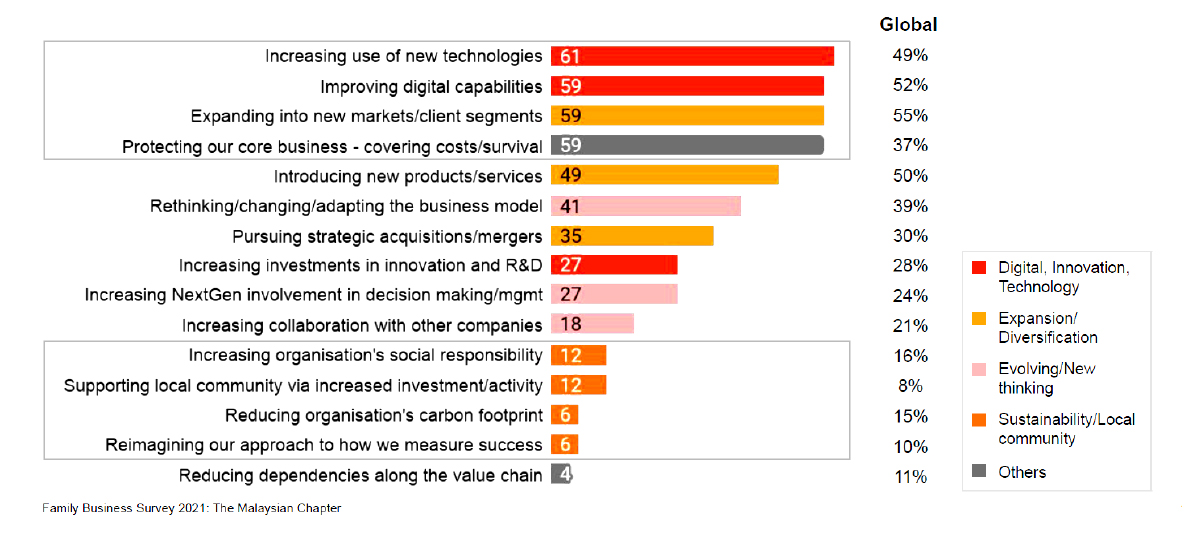
This article first appeared in Digital Edge, The Edge Malaysia Weekly on April 26, 2021 - May 2, 2021
Malaysian family businesses currently put rapid digital transformation as their top priority, which is a significant turning point in mindset, according to a recently published report by PwC.
Released on April 9, the Malaysian edition of the Family Business Survey 2021 states that 61% of local family businesses are prioritising the increased use of new technologies, while 59% are looking to improve their current digital capabilities as one of their top business priorities.
This is in stark contrast to PwC’s previous Family Business Survey, in 2019, in which the majority of next-generation business owners (NextGens) believed that their family businesses were undifferentiated from their competitors when it came to the effective use of technology. That year, only 24% of NextGen respondents rated themselves as being very technologically savvy.
“Before, many Malaysian businesses had been considering going digital for the longest time. Then suddenly, with the Covid-19 pandemic, everyone had no choice but to switch to digital — from setting up an online business to accepting QR codes,” says Fung Mei Lin, PwC Malaysia’s entrepreneurial and private business leader.
“The pandemic was definitely a factor in accelerating digital transformation. For many family businesses, digitalisation has always been at the back of their minds to begin with. Some already made plans for this, five to 10 years ago, but it is the speed of execution that will vary from business to business.”
Once treated as a mere consideration, improving digital capabilities has now become a necessity owing to the social and economic effects of the pandemic. Despite the digitalisation movement garnering massive interest in recent months, 76% of Malaysian family businesses surveyed still feel that they have a long way to go and are currently trailing behind their peers in Asia-Pacific, North America and Europe.
In comparison, only 62% of the family businesses surveyed globally feel that they still have a long way to go when it comes to achieving digital capabilities within the business.
“As it is, in terms of digital skills competitiveness, Malaysia’s family businesses face the risk of being left behind in the digital space compared to their regional counterparts. Our survey revealed that 33% of Asia-Pacific respondents say that they have strong digital capabilities, compared to 41% in North America and 43% in Europe,” the report highlights.
Shifting towards NextGens and professionals
In this scenario in which Malaysian family businesses are playing catch-up with their global peers, NextGens are in a unique position to lead the family business digital transformation initiatives.
Compared with their global peers, Malaysian NextGens are much more proactively involved in the family business at both board and management levels. For example, 57% of Malaysian NextGens currently sit on the management committee, compared with 29% globally. The report also forecasts that a larger proportion of Malaysian NextGens will be majority shareholders in their family businesses within the next five years.
At this inflection point, trust and communication between family members are key factors in driving the direction of the business. However, there are gaps within this space, as only 45% of survey respondents say that all family members involved in the business are on the same page in terms of company direction and priorities, and only 57% say that relevant business information is shared among family members in a transparent way.
“In some cases, the current generation may feel that the younger generation does not appreciate the foundation of hard work and may question their suggestions. This may be more prevalent in Asian cultures, which have a much more patriarchal approach to succession planning,” the report states.
“In other instances, NextGen family members may voice their frustration over not knowing if or when they will become owners, or how much ownership they will receive. As a result, they feel the tremendous pressure and urgency to prove that they deserve the position and that they can perform.”
According to Fung, the pandemic era also marks another major shift within the mindset of local family businesses — the transition from being family-run to family-owned. She points out that the drive for digital transformation has certainly had a hand in this transition.
“There are so many aspects when it comes to digital transformation, which extends beyond just the technology. There are also change management, cultural shifts and the potential changing of many long-established internal business processes — all of which you need leaders with the right skill set to execute,” says Fung.
“Sometimes, these leaders can be family members, but there are also times in which businesses need to source these leaders externally. This is where professional managers can help local businesses with their digital transformation objectives, and I notice that more and more family businesses are much more accepting of business professionalisation.”
Bridging the digital gap
Fung highlights that family businesses and non-family corporate entities may approach digital transformation differently, owing to the different business goals and objectives. She says in a family business environment, the company tends to prioritise company sustainability and will invest in projects that hold long-term value.
“Family businesses are much more willing to invest in a project that would only generate positive returns after 10 years. [Whereas in] a non-family business organisation, the CEO may think twice before embarking on this project because the CEO may not even be there after 10 years.
“When speaking to family businesses, you can get an insight into their mindset when making investment and business decisions. In addition to focusing on profitability, one of the common questions that come to their mind is whether the investment is going to benefit their children in the future.”
When asked if the different approaches towards digital transformation will widen the digital gap between family and non-family corporate entities, Yap Sau Shiung, PwC Malaysia’s head of digital solutions and tax partner, points out that this may not be the case.
“Yes, larger corporations tend to have more financial and resource bandwidth at their disposal, so in terms of the scale and speed of digital adoption, corporations tend to outperform their family-run counterparts, who may not have the same financial muscle,” says Yap.
“However, just because digital transformation is slower, it does not mean that the digital divide between these two types of entities will widen. Family businesses tend to be smaller, but they are also much more nimble. Once the family business management team is on the same page in terms of company vision and direction, digital adoption can be accelerated.”
For NextGens looking to drive digital transformation within their business, the report highlights several key areas to focus on:
1 Setting up a flexible digital budget policy
Although budgets may vary and increase depending on the business requirements, the report recommends dedicating between 2% and 5% of the company’s revenue to finance digital transformation initiatives as a starting point.
2 Enable citizen-led innovation
Citizen-led innovation is where employees are allowed to develop their own micro-digital solutions aimed at improving processes and creating efficiencies within the business. This cultivates an innovative mindset among employees, who may have found ways to automate menial tasks.
This is indicative of another PwC report released last year stating that 85% of employees have strong appetites for learning new skills and are willing to completely retrain to improve their future employability.
3 Becoming data-savvy
The report states that at the centre of any digital transformation project lies intelligent management, which relies heavily on data.
In an increasingly data-driven world, NextGens may have to learn how to understand data and how it is accumulated throughout the entire business processes. Doing so allows NextGens to gain insights such as customer preferences, market trends and sales team performances — allowing them to make much more informed business decisions.
Save by subscribing to us for your print and/or digital copy.
P/S: The Edge is also available on Apple's App Store and Android's Google Play.
- Public Bank heir buys Singapore mansion for record US$70m — Bloomberg
- Wawasan Dengkil slips after flat open on ACE Market debut
- PM reveals attack on MAHB digital system with hackers demanding US$10 mil
- YTL Communications collaborates with Transcelestial to bring laser-based wireless technology to Malaysia
- Samsung Electronics co-CEO passes away of heart attack at 63
- Gold edges higher as surge in ETF holdings continues
- Britain gives go-ahead to new US$13 bil Thames tunnel
- Cape EMS teams up with Taiwanese aerospace firm to enter into aerospace parts, expand renewable energy
- US consumers slow spending as inflation bites, Synchrony says
- European shares helped by optimism around tariffs, dollar perks up



